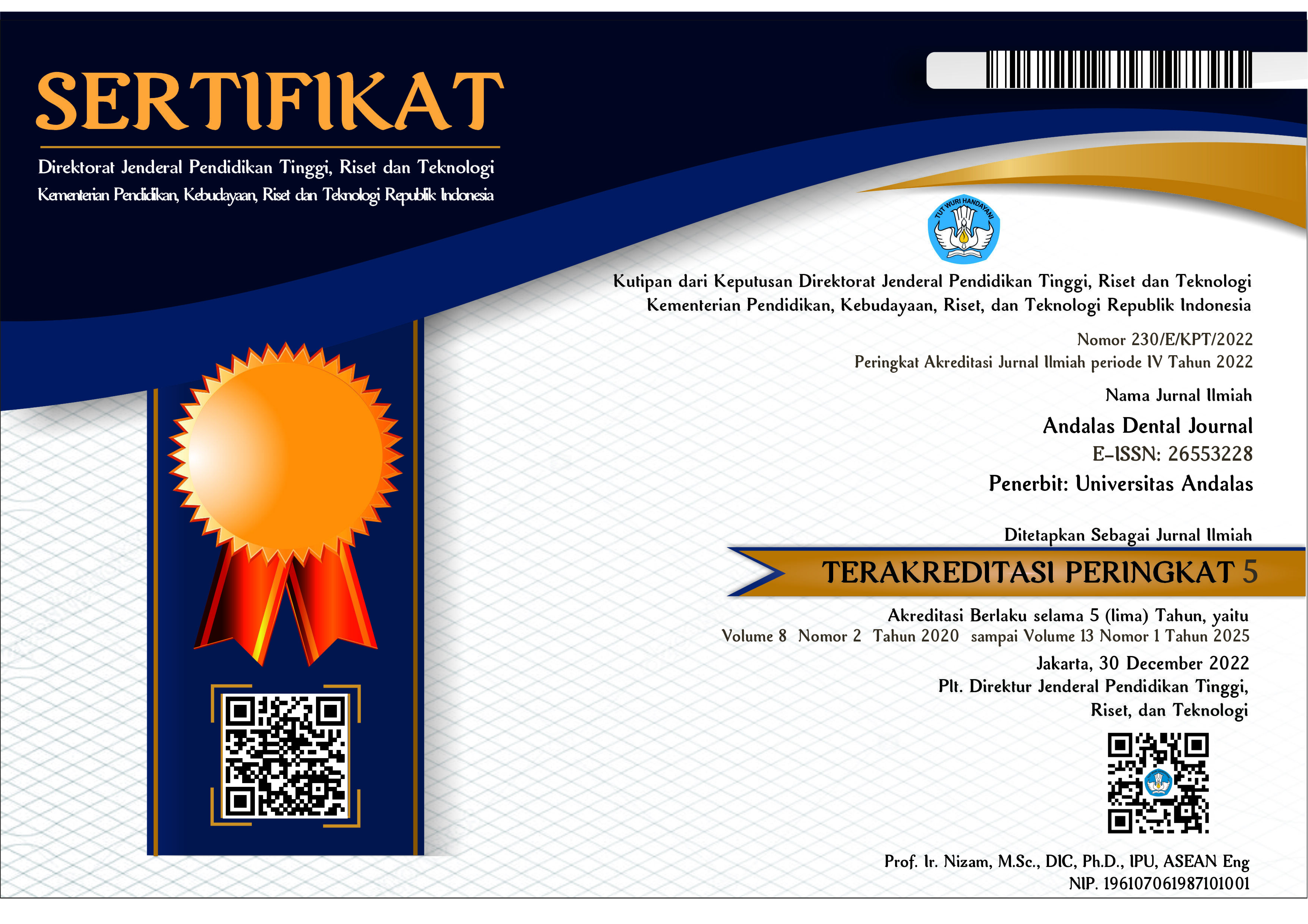Pengaruh Kebiasaan Menyikat Gigi Sebelum Tidur Malam Hari Terhadap Status Gingiva Pada Siswa Sekolah Dasar Kelas I Dan V
Abstract
The low level of public awareness causes a negative impact on oral health, especially for children. The bad effects that can occur are gingivitis. One of the factors that cause gingivitis is plaque. Therefore, this study wanted to determine whether the habit of brushing teeth before sleeping at night had an effect on gingival status. The purpose of this study was to determine the effect of brushing teeth before going to bed at night on gingival status in grade IV and V students of SDN 08 Parak Gadang Barat, Padang, Prov. West Sumatra. This type of research is analytical with aresearch design cross sectional. The number of research samples was 34 children. The data collection method was conducted by interviewing and checking the gingival status using the Gingival Index according to Loe and Silness. Based on the results of the study, it was found that 55.9% of respondents had mild gingivitis and 52.9% of respondents had a habit of not regularly brushing their teeth at night before going to bed. Then, based on the results of thebivariate analysis Chi-Square, it was found that the habit of brushing teeth before going to bed at night with gingival status (p <0.05). The conclusion of this study was that the habit of brushing your teeth at night before going to bed affected the gingival status.
References
2. Louis F. Rose, B. L., Periodontics : Medicine, Surgery and Implants. 2004.
3. Lindhe, J., linical Periodontology and Implant Dentistry, 5th edition., Implant Dentistry. 2009.
4. The American Academy of Periodontology. Parameters of Care Supplement, Journal of Periodontology. 2000.
5. Cugini, M. A., Thompson, M. and Warren, P. R., Correlations between two plaque indices in assessment of toothbrush effectiveness, Journal of Contemporary Dental Practice. 2006: Vol. 7(5).
6. Putri, M. H., Ilmu pencegahan penyakit jaringan keras dan jaringan pendukung gigi. Jakarta. 2011.
7. Walsh, L., Clinical aspects of salivary biology for the dental clinician, International Dentistry South Africa. 2007.
8. Amerongen, Ludah dan kelenjar ludah arti bagi kesehatan gigi. gajah mada universitas press. 1991.
9. Daliemunthe, S.H., Pengantar Periodonsia. Universitas Sumatera Utara. 2008, pp. 99, 105-118.
10. Singh, M. et al., Prevalence of dental diseases in 5- to 14-year-old school children in rural areas of the Barabanki district, Uttar Pradesh, India‟, Indian Journal of Dental Research. 2011.
11. Deepak P Bhayya, Tarulatha R Shyagali, M. and K., Study of oral hygiene status and prevalence of gingiva diseases in 10-12 years school children in Maharashtra, India, J. Int Oral Health. 2010.
12. Rosema, N., van Palenstein Helderman, W. and Van der Weijden, G., Gingivitis and plaque scores of 8 to 11 years old Burmese children following participation in 2 years school-based tooth brushing programme, International Journal of Dental Hygiene. 2012.
13. Kartono, K., Psikologi Perkembangan. Bandung: Mandar Maju. 1990.
14. Hestieyonini, H., Pengaruh Pola Jajan Sekolah Terhadap Karies Gigi Pada Siswa Sekolah Dasar Di Kab. Jember. Journal of Dentistry Indonesia. 2002.
15. Trisye S., Paulina N.G. dan Juliatri., Status Kebersihan Mulut Anak Usia 9- 11 Tahun dan Kebiasaan Menyikat Gigi Malam Sebelum Tidur Di SDN Melonguane. 2015.
16. Ardiani, D.K., A.W.S. Dharmayanti, dan P. Pujiastuti., Kadar Fosfor (P) dalam Cairan Sulkus Gingiva pada Penderita Penyakit Periodontal. IDJ, 2014; 3(1): 1-8.
17. Perry, D.A., P.L. Beemsterboer, dan G. Essex., Periodontology for the Dental Hygienist. 4th Edition. Elsevier Saunder. 2015.
18. Lindhe, J. Clinical Periodontology and Implant Dentistry, 5th edition., Implant Dentistry. 2009.
19. Gundala R., Chava V.K., Effect of Lifestyle, Education andSocioeconomic Status on Periodontal Health. Contemporary Clinical Dentistry. 2010.
20. Reisa, Siagian, Status Kesehatan Gingiva Anak Usia Sekolah Dasar Menurut Kebiasaan Menyikat Gigi Sebelum Tidur Malam Hari(studi kasus di SDN Anyelir 1 Depok). 2007.
21. Potter, P.A., Perry, A.G., Buku Ajar Fundamental Keperawatan: Konsep, Proses, dan Praktik (Vol 2 edisi ke-4) (Yasmin Asih et al, Penerjemah). Jakarta: EGC. 2005.
22. Anna M. Maruanaya, Ni Wayan Mariati, dan Damajanty H.C. Pangemanan., Gambaran Status Gingiva Menurut Kebiasaan Menyikat Gigi Sebelum Tidur Malam Hari Pada Siswa Sekolah Dasar Negeri 70 Manado. Journal e-Gigi (eG), 2015; 3(2): 246-251.
23. Fara M.Lossu, Damajanty H.C.P. dan Vonny N.S.W., Hubungan Pengetahuan Kesehatan Gigi dan Mulut Dengan Indeks Gingiva Siswa SD Katolik 03 Frater Don Bosco Manado.Jurnal e-Gigi 2015; 3(2): 647-653.
24. Berchier CE, Slot DE, Haps S., The efficacy of dental floss in addition to a toothbrush on plaque and parameters of gingival inflammation: a systematic review, Int J Dent Hyg, 2008; 6: 265–279.
25. Samaranayake, L., Essential Microbiology for Dentistry. 5th Edition. Churchill Livingstone Elsevier, 2018, pp. 261-264.
26. Manson, J. D., Eley, B. M., Outline of Periodontics. Jakarta: Hipokrates. 1993.















